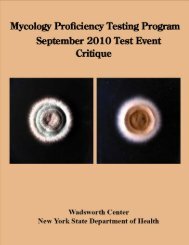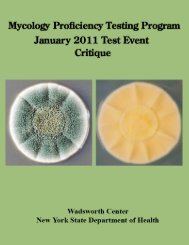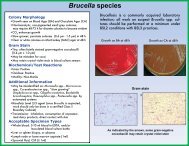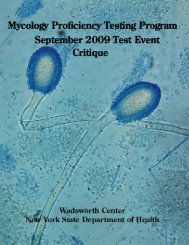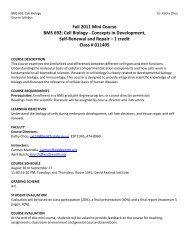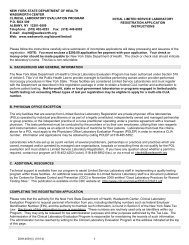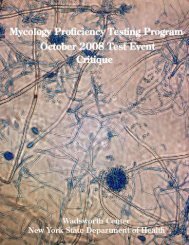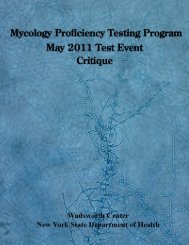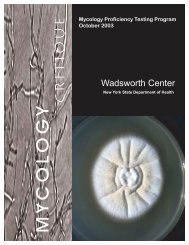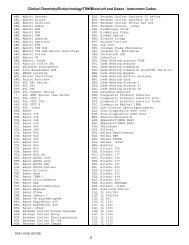September 2007 - Wadsworth Center
September 2007 - Wadsworth Center
September 2007 - Wadsworth Center
You also want an ePaper? Increase the reach of your titles
YUMPU automatically turns print PDFs into web optimized ePapers that Google loves.
Y-3 Candida viswanathiiSource: CSF / UrineScoring:No. LaboratoriesReferee Laboratories with correct ID: 0Laboratories with correct ID: 1Laboratories with incorrect ID: 50(Candida lusitaniae) (39)(Candida tropicalis) (5)(Candida haemulonii) (3)(Candida guilliermondii) (2)(Candida famata) (1)Clinical Significance: C. viswanathii is a very rare yeast pathogen in clinical specimens. Only a few casereports exist on its recovery from the cerebrospinal fluid or sputum of patients with meningitis.Ecology: C. viswanathii was first reported from the sputum and CSF from meningitis patient in India. Asubsequent report described it from shrimp in Gulf of Mexico.Laboratory Diagnosis:1. Culture – On Sabouraud’s dextrose agar at 25°C for 3 to 5 days, colony was white or cream, a littlewrinkled, moist (Figure 17).2. Microscopic morphology – On corn meal agar with Tween 80, C. viswanathii formed long pseudohyphaeand elongated, oval shaped blastoconidia. The truncated scar was observed at the attached site (Figure18).3. Differentiation from other yeasts – C. viswanathii grows on the media containing cycloheximide andgrows well at 37°C. It ferments glucose and maltose, and many other physiological characteristics arevery similar to C. albicans and C. tropicalis. However, on microscopic morphology, C. viswanathii haslong pseudohyphae with elongated oval shaped conidia with truncate scars, which differentiates it fromC. tropicalis. Absence of chlamydospore and germ tube differentiates it from C. albicans.4. In vitro susceptibility testing – No information available.5. Molecular tests – DNA hybridization and electrophoretic karyotyping or restriction enzyme analysis ofPCR products obtained from the gene coding for the small ribosomal subunit 18S-rRNA were applied fordifferentiation of C. viswanathii from other medically relevant yeasts.The identity of the test isolate was confirmed in Mycology PTP program by sequencing of its ITS1 andITS2 regions of rDNA. 100% identity was found between this PT specimen and C. viswanathii ATCC 22981(Genebank accession number: AY139791) for ITS1 and C. viswanathii WM 239 (Genebank accessionnumber: DQ249200) for ITS2 region.Comments: There is no bicode for C. viswanathii in the API 20C AUX database. C. viswanathii grows onthe media containing cycloheximide, differentiating it from C. parapsilosis, C. lusitaniae, C. krusei, and C.zeylanoides. C. viswanathii ferments glucose, but C. lipolytica does not. C. viswanathii has prominenttruncated scars on the blastoconidia differentiate it from other physiologically close yeasts including C.tropicalis.39



